PSEB Solutions for Class 9 Science Chapter 12 Sound
PSEB Solutions for Class 9 Science Chapter 12 Sound
PSEB 9th Class Science Solutions Chapter 12 Sound
→ Sound is a kind of energy that produces a sensation of hearing in our ears.
→ Sound is produced due to vibrations of an object, Vibration means the to and fro movement of an object.
→ In human voice, the sound is produced due to the vibration of the larynx.
→ The substance through which sound travels is called medium.
→ Wave is a sort of disturbance.
→ For transmission of sound, a medium is required and the air is generally used as a medium.
→ Sound can not travel through a vacuum.
→ In transverse waves, the particles of the medium vibrate in a direction perpendicular to the direction of propagation of the wave.
→ The distance between two consecutive rarefactions is called wavelength.
→ The movement of compressions passing through a point in a unit of time is called frequency.
→ The time taken by two consecutive compressions or rarefactions passing through a fixed point is called the frequency of the wave.
→ The relation between velocity (υ), frequency (ν) and wavelength (λ) of the wave is υ = ν × λ
→ The velocity sound depends mainly upon the nature of medium and temperature.
→ To hear an echo the minimum time elapsed between the original sound and reflected sound should be 0.1 seconds.
→ Sound energy passing through a unit area in 1 second is called the intensity of sound.
→ The human audible range is 20 Hz to 20 kHz.
→ Sound travels through a substance in the form of longitudinal waves.
→ Sound travels through air medium in the form of compressions and rarefactions.
→ Compression is a region of high pressure and maximum density.
→ Sound: It is a kind of energy that produces in us the sensation of hearing.
→ Amplitude: The maximum displacement of the particle of the medium on either side of its mean position during vibration is called its Amplitude.
→ Frequency: The number of vibrations made by the vibrating body in 1 second is called its frequency.
→ Wavelength: Whatever time is taken by the particle to complete 1 vibration during the same time the distance travelled by the wave is called wavelength. It is denoted by ‘λ’.
→ Wave velocity: In a medium, the magnitude of the product of frequency and wavelength of a wave is equal to wave velocity i.e. υ = ν × λ
→ Oscillation or Vibration: The to and fro motion of a vibrating particle about its mean position to complete 1 vibration is called oscillation or vibration.
→ Periodic motion: The motion which is repeated after a fixed interval of time is called periodic motion,
→ Rarefaction: In longitudinal waves, the region where the particles of the medium are farther apart than the normal distance is called rarefaction. Here the pressure is lower than normal.
→ Echo: The reflected sound is called echo.
→ Transverse waves: Those waves in which the particles of the medium vibrate about their mean position in a direction perpendicular to the direction of propagation of the wave, such waves are called transverse waves.
→ Longitudinal waves: Those waves in which the particles of the medium vibrate forward and backward in the same direction in which the wave travels then the wave is called a longitudinal wave.
→ Ultrasonic waves: Those longitudinal waves which have a frequency of more than 20000 Hertz (Hz) are called ultrasonic waves.
→ SONAR (Sound Navigation and Ranging): It is a device that measures the time for producing sound waves and reflected waves.
→ Time Period: The time taken to complete one complete vibration (i.e. to travel from mean position to one extreme position than to other extreme position and back is called time period. It is denoted by ‘T’ and expressed in seconds.
→ Compression: Due to the forwarding motion of the longitudinal wave, the region where the particles of medium come close to each other than the normal distance between them is called compression. Here the pressure is higher than normal.
PSEB 9th Class Science Important Questions Chapter 12 Sound
Long Answer Type Questions:
Question 1.
(A) Name two different types of waves.
(B) Give an experiment to explain the formation of transverse waves.
(C) Define transverse waves.
(D) What should be the conditions for the production of transverse waves?
(E) Give examples of transverse waves.
(F) Define crest and trough.
Answer:
(A) Types of Waves: Waves are classified according to the direction of vibration of particles of the medium. It can be either in the direction parallel to the direction of propagation of wave or in a direction perpendicular to the direction of propagation. In this way waves are of two types:
- Transverse waves
- Longitudinal waves.
(B) Formation of Transverse waves. To understand the formation of transverse waves attach one end of a long string to the hook fixed in the wall as shown in the figure, Hold the other end of the string in your hand. The coloured threads of length 10 cm each with the string at equal distance as shown in the figure.
image
Now give jerk to the slinky. An upward maund or hump is formed in the string which travels along the string towards the fixed end. Such sudden disturbance that lasts for short duration is called pulse i.e. the particles of string move along with the disturbance in the perpendicular direction.

As shown in fig. (c) if we continuously give up and down jerks to the free end of the string a number of waves begin to travel along the string forming a wave train. Each part of the string vibrates up and down while the waves travel along the string. So the waves in the string are transverse in nature.
The points (c, c, c …………… ) of maximum displacement in the upward direction are called crests and the points (T, T, T…………) of maximum displacement in the downward direction are called troughs.
(C) Transverse Wave: These are the waves in which particles of the medium vibrate (up and down) in a direction perpendicular to the direction of propagation of wave.
(D) Conditions necessary for formation of transverse waves:
- The medium should have property of inertia.
- The medium should have property of elasticity so that the particles can come back to their original positions after being disturbed.
- The medium should have minimum frictional force between its particles so that the particles may keep vibrating for a long.
- Vibrations of plucked stretched string of a violin.
(E) Examples of Transverse Waves.
- In loose string or spring: If a string is held in hand and the other end is tied to a fixed support and it is continuously moved up and down then transverse waves are produced.
- Wave on the surface of still water: If a pebble is dropped gently on the surface of still water of a pond then ripples are produced on the water surface.
- A cork floating on the surface of water would then begin to vibrate up and down then transverse waves are produced. The cork is not displaced with the waves but keeps tossing up and down,
(F) Crests and Troughs:
- Crests: In transverse waves, the particles of the medium which have maximum displacement in the upward positive direction along Y-axis are called crests.
- Troughs: In transverse waves, the particles of the medium which have maximum displacement in the downward negative direction along Y-axis are called troughs.
Question 2.
(A) Define longitudinal wave.
(B) Arrange an experiment to demonstrate the formation of longitudinal wave.
(C) In reference to longitudinal wave, define compressions and rarefactions.
Answer:
(A) Longitudinal wave. Those waves in which the particles of the medium vibrate about their mean position in the direction of propagation of disturbance are called longitudinal waves and the wave motion is called the longitudinal wave motion. Sound in air gets propagated in the form of longitudinal wave motion consisting of regions of compressions and rarefactions.

(B) Experiment: Consider, a tuning fork struck gently with a rubber pad so that its prong begins to vibrate [Fig. (a)]. As prong moves towards right, it compresses the layer of air in contact with it. As air has elasticity, the compressed air tends to relieve itself of its strain and moves towards the right to compress the next layer and so on.
Thus, a wave of compression moves towards the right. At the point of compression, there is an increase of pressure and is shown in form of crest C. At the point of rarefaction of concentration of particles is least and has been shown as trough R. When the prong moves towards left, a region of reduced pressure or rarefaction is produced towards right [Fig. (b)].
Examples:
- Hearing in man,
- Vibrating tuning fork,
- Beating diaphragm of drum.
(C) Compressions and Rarefactions:
Compression: The region of high pressure in the longitudinal wave so that the particles of the medium are closer to each other than the normal distance between them. The higher the pressure, the higher is the number of particles per unit volume i.e. higher is the density, is called compression. In fig it is denoted by ‘c’.
Rarefaction: The region of low pressure in the longitudinal wave so that the particles of the medium are far away from each other than the normal distance between them, is called Rarefaction. In fig it is denoted by ‘R’.
Question 3.
Establish the relation between wave velocity, wavelength and frequency of a wave.
Solution:
Suppose
υ = Wave velocity
ν = Frequency of the wave (i.e. frequency of vibrating particles of the medium)
λ = Wavelength of wave.
T = Time period of a vibrating particle (i.e. time taken by particle of the medium to complete 1 vibration)
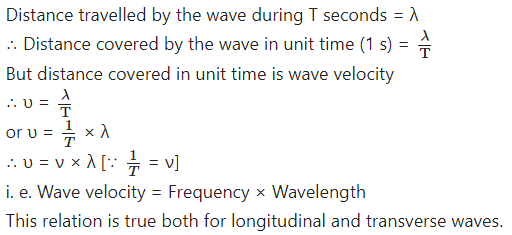
Question 4.
Distinguish between sound waves and light waves.
Answer:
Difference between sound waves and light waves
| Sound Waves | Light Waves |
| 1. Sound waves are mechanical waves. | Light waves are electromagnetic waves. |
| 2. Sound waves are longitudinal waves in which the direction of vibration of particles of the medium is same as that of propagation of wave. | Light waves are transverse waves in which the vibration of the particles of the medium is in a direction perpendicular to the direction of propagation of wave. |
| 3. Sound waves can not travel through vacuum. These require some material medium. | Light waves can travel through vacuum. |
| 4. Speed of sound waves in air is 340 m s-1. | Speed of light waves in air is very large. It is 3 × 108 m s-1. |
| 5. Sound waves are produced due to vibrations of particles of related medium. | Light waves depend upon the change in electromagnetic fields. |
| 6. Sound waves have low frequency and large wavelength. | Light waves have high frequency and small wavelength. |
| 7. Sound waves cannot be polarised. | Light waves can be polarised. |
| 8. Sound waves produce effect on our ears. | Light waves produce effect on our eyes. |
| 9. The velocity of sound waves is independent of the wavelength of wave. | The velocity of lightwave depends upon the wavelength of the wave. |
Question 5.
Explain the classification of sound waves on the basis of frequency range.
Answer:
1. Audible waves: Those sound waves to which human ears can respond (i.e. those sounds waves which can be heard by human beings). In human beings the audible range is from 20 Hz to 20,000 Hz. As the human being advances in age his ears become less sensitive to sounds of high frequencies. These waves are produced by vibrations in air column, tuning fork and violin.
2. Ultrasonic waves: The sound waves having frequency above 20 KHz (i.e. 20,000 Hz) are called ultrasonic waves or ultrasonics. Insects of some species can hear such sound waves. Bats, dolphins, etc. produce such sound waves.
3. Infrasonic waves: Those sound waves which have frequency less than 20 Hz are called infrasonic waves or infrasonics. Whale and elephants produce infrasonic waves. These waves are produced before the main high frequency waves of earthquake occur on hearing these waves the animals become terrorised and become impatient.
Question 6.
What are the laws of reflection of sound? How will you prove these laws experimentally?
Answer:
Like light, sound also obeys the laws of reflection these are:
1. The angle made by incident sound and reflected sound with the normal to the reflecting surface at the point of incidence are always equal.
i.e. ∠i=∠r
2. The incident sound, the normal at the point of incidence and the reflected sound all lie in the same plane.

Experimental Verification:
Take two cardboard tubes A and B about 1 m long and 5 cm in diameter. Mount the tubes as shown in figure facing metal plate as shown in fig. Place a watch at the mouth of the tube A and try to hear the sound by applying ear close to the end of the tube B.
Place a screen S made of cardboard or of some other absorbing material in between the two tubes to prevent sound from reaching our ear directly. It will be observed that the sound is maximum when angles made by tubes A and B with normal are equal i.e., ∠i=∠r
Question 7.
List the three characteristics of sound waves. State the factors on which each of these characteristics depends.
Answer:
Characteristics of sound: The three characteristics of sound are
- Loudness
- Pitch and
- Quality or timbre.
1. Loudness: It is the response differently i.e., one sound louder than the other of ear to the intensity of sound. It distinguishes between a loud sound and soft (low) sound. Even two sounds of equal intensity, may hear. Loudness depends on two main factors.
Factors on which sound depends:
(a) Intensity of sound
(b) Sensitivity of ear.
Graphs given below show the wave shape of a loud sound and a soft sound having the same frequency.
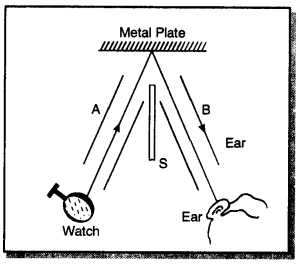
2. Pitch: Pitch is the sensation which helps a listener to distinguish between a high and a low note. Pitch depends on frequency. The faster the vibration of the source of sound, the higher is the frequency and higher is the pitch,
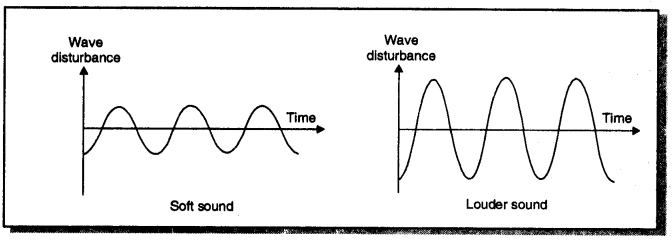
The voice of a child or a lady is shriller than that of a man i.e., the pitch of a lady’s sound is higher than that of a man. The mosquito’s sound is of high frequency and hence high pitch.
3. Quality or timbre. The quality or timber of sound is that characteristic which helps us, to distinguish one sound from another having the same pitch and loudness. It is due to the quality of sound that one can recognise the voice of friend without seeing him.
Short Answer Type Questions:
Question 1.
What is periodic motion? Give three examples.
Answer:
Periodic motion: The motion of a body that repeats itself regularly after a fixed interval of time is called periodic motion. Such type of motion is vibratory motion.
Examples of periodic motion.
- Motion of the earth around the sun.
- The motion of a swing which moves to and fro (left and right) about its mean position.
- The motion of a simple pendulum.
- The motion of the hands of a clock.
Question 2.
Define oscillatory motion. Give examples.
Answer:
Oscillatory or vibratory motion. If a body moves to and fro repeatedly about a fixed position (called mean position), its motion is said to be oscillatory or vibratory motion.
Examples of oscillatory motion:
- Motion of the pendulum of a wall clock.
- Motion of a swing.
Question 3.
Differentiate between transverse waves and longitudinal waves.
Answer:
Differences between transverse and longitudinal waves:
| Transverse waves | Longitudinal waves. |
| 1. In transverse waves, the particles of the medium vibrate perpendicular to the direction of wave motion. | In longitudinal waves, the particles of the medium vibrate along the direction of wave motion. |
| 2. These waves travel in the form of alternate crest and troughs. | These waves travel in the form of alternate compressions and rarefactions. |
| 3. These waves can be transmitted through solids or liquid surfaces. | These waves can be transmitted through all the three media, viz (i) solids, (ii) liquids and (iii) gases. |
| 4. They do not cause pressure changes in the medium through which they pass. Example. Waves formed over water surface. | They cause changes in the pressure of the different parts of the medium through which they pass. Example. Sound waves in air, |
Question 4.
How is sound propagated? Can it be propagated through vacuum? out of solid, liquid and gas in which medium speed of sound is maximum and in which it is least?
Answer:
The propagation of sound is in the form of transverse waves therefore sound waves consist of compressions and rarefactions. The source of sound is always in vibrating state. The sound emitted by a vibrating source can always propagates through a medium.
Sound can not travel through vacuum. Transverse waves can travel through all the three mediums solid, liquid and gas. This happens due to elasticity of the medium. Solids are more elastic than liquids and gases. It has been proved experimentally that the speed of sound is maximum in solids the least in gases.
Question 5.
What are applications of ultrasound?
Answer:
Applications of ultrasound:
- Glaton whistle. It is used by hunters. When hunter and hound (hunting dog) get separated an hunter wants to call back dog to help him catch the prey, he blows the Glaton whistle which produces only ultrasonic waves.
- These waves can be heard by dog but not by other animals and birds of the forest.
- Bats judge the distance of prey or the coming obstacle by sending these waves. By observing the time taken by waves to travel back, they can find the distance of the obstacle/ prey.
- Ultrasound waves are used to find the depth of the sea.
- Ultrasonic waves are used by doctors for scanning different parts of the body.
- These waves are used by dentists to compress the silver filled in the cavity of teeth.
- These are used to clean parts located in hard-to-reach places. Objects are cleaned in cleaning solution and ultrasonics are passed in the solution.
- Particles of dust, grease get detached due to high-frequency vibrations and get into cleaning solution.
Question 6.
Define the terms wave and wave motion.
Answer:
Wave and wave motion. A wave is a pattern of disturbance which travels through a medium due to repeated vibrations of the particles of the medium, the disturbance being handed over from one particle to the next. The motion of the disturbance is called wave motion.
Question 7.
Distinguish between a wave pulse and a periodic wave.
Answer:
| Pulse | Periodic wave |
| 1. A pulse is a wave produced by a sudden disturbance of short duration. | A periodic wave produced by continuous and regular vibrations of the particles of the medium. |
| 2. Due to pulse, the medium oscillates for a short time and then returns to its undisturbed position. | Due to periodic wave, medium vibrates for a long time after being disturbed. |
| 3. It is not repetitive. | It repeats itself after a fixed interval. |
| 4. It is formed in a small portion of the medium. | It spreads over the entire length of the medium. |
Question 8.
What are mechanical or elastic waves? Give examples.
Answer:
Mechanical waves: The waves which require a material medium for their propagation are called mechanical waves. They are also called elastic waves because their propagation depends on the elastic properties of the medium.
Examples of mechanical waves:
- Sound waves in air.
- Waves over water surface
- Waves produced during an earthquake. These are known as seismic waves.
Question 9.
State two factors on which the speed of sound depends.
Answer:
The speed of sound through a medium depends on following two factors:
- Nature of the medium.
- Temperature of the medium.
Question 10.
Explain in brief the dependence of speed of sound on nature of material medium and temperature.
Answer:
Speed of sound in different media. Sound travels fastest through solids and slowest through gases. This is because elasticity of solids is much greater than that of liquids which in turn, is greater than that of gases.
Effect of Temperature. The speed of sound increases with the increase in temperature of the medium through which sound travels.
Question 11.
Define the terms time period and frequency of an oscillating body. Give their units and write the relation between them.
Answer:
Time period: The time taken by an oscillating body to complete one oscillation is called its time period. It is denoted by T. Its SI unit is second(s).
Frequency: The number of oscillations or vibrations completed by an oscillating body in one second is called its frequency. It is denoted by ν (Greek letter nu).
SI unit of frequency = per second (s-1) = cycles per second (cps)
= hertz (Hz).
Relation between time period and frequency.
Let T = time period of an oscillating body. Then,
number of oscillations completed in “T second = 1
number of oscillations completed in 1 second = 1/T
But number of oscillations completed in 1 second = frequency (ν)
∴ ν = 1/T
Hence frequency is equal to the reciprocal of time period.
Question 12.
Give two practical applications of reflection of sound waves.
Answer:
Two practical applications of reflection of sound waves:
1. Reflecting boards. In large halls or auditorium large wooden boards are fixed behind the speaker in the form of a concave cylinder. The sound waves on striking the reflecting boards get reflected parallel to the principal axis reaches everyone in the auditorium so that everyone can hear clearly. The working of reflective board is based on reflection.

2. Ear trumpet. The sound energy received by the wide end of the trumpet is reflected into much smaller area thereby increasing the intensity of sound. Hence, a person who is hard of heamg, can hear the sound distinctly.
Question 13.
Distinguish between the terms music and noise.
Answer:
- Music: The sound which has a pleasing sensation to the ears is called music. It is produced by regular and periodic vibrations, without any sudden change in loudness.
- Example: The sound produced by plucking the string of a sitar, sound from a tabla, etc.
- Noise: The sound which has a displeasing on the ears is called noise. It is produced by vibrations at irregular intervals and with sudden change in loudness.
- Example: The sound produced by an explosion.
Question 14.
How can bats ascertain distances, directions, nature and size of the obstacles without eyes?
Answer:
Bats can produce and receive ultrasonic waves. During flight, a bat emits ultrasonic waves. The bat receives back these waves after being reflected by the obstacle in its path. From the time interval between transmission and reception of ultrasonic waves, the bat gets information about the distance, nature of obstacle and its direction of location. Hence bats can move about freely even in total darkness.
Question 15.
It is observed that some animals get disturbed before earthquake. How?
Answer:
Earthquakes produce low-frequency infrasound before the mainshock waves begin. These infrasonic waves are out of our audible range. But animals are able to detect these waves and hence some animals get disturbed before earthquakes.
Important Formulae:
- Wave Velocity (υ) = ν × λ
- Frequency (ν) = 1/T
- Wave length (λ) = v × T
- Total Distance = Velocity × Time
Numerical Problems (Solved):
Question 1.
What will be the frequency of Mohan’s heart when it beats 75 times in 1 minute?
Solution:
Time taken for 75 heart beats = 1 min
= 60 s
and time taken for 1 heartbeat = 60/75
∴ Time period (T) = 0.80 s
We know, frequency (ν) = 1/Time Period(T)
= 1/0.80
= 1.25 Hertz (Hz)
Question 2.
A boat strikes waves of ocean having crest 100 m away. The wave velocity of crest is 20 m s-1. What is the frequency of waves striking the boat?
Solution:
Wave length (λ) = 100 m
Wave velocity (υ) = 20 m/s
Frequency (ν) = ?
We know, υ = ν × λ
20 = v × 100
or ν = 20/100
= 0.2 Hertz (Hz)
Question 3.
A source of wave produces 40 crests in 0.4 s. Find the frequency of wave.
Solution:
A wave cycle consists of one crest and one trough.
Since the given source produces 40 crests, it produces 40 wave cycles in 0.4 s.
No. of wave cycles produced in 0.4 s = 40
No. of wave cycles produced in 1 s = 40/4
= 100
∴ Frequency of wave = 100 Hz
Question 4.
A source produces a sound of wavelength. 1.7 x 10-2 m. If its velocity is 343.4 m s -1, then find frequency of sound,
Solution:
Velocity, υ = 343.4 ms-1
Wave length, λ = 1.7 × 10-2 m;
Frequency, ν = ?
We know, υ = ν × λ

Question 5.
What will be the frequency of the wave, if its time period is 0.05 s?
Solution:
Here Time Period T = 0.05 s
Frequency, ν = ?
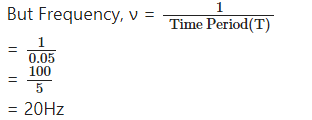
Question 6.
A distance displacement of a periodic wave is shown in a graph, if velocity of the wave is 320 m s-1 , then find (a) wavelength (b) frequency.
Solution:
(a) Wavelength = Distance between two consecutive crests
= 50 – 10
= 40 cm
= 40/100 m/s
= 0.4 m
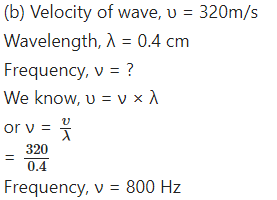
Question 7.
Longitudinal waves is produced on a spring. This wave travels with a velocity of 30 cm/s and its frequency is 20 Hz. What is the minimum distance between two consecutive compressions?
Solution:
Here, wave velocity, υ = 30 cm/s
= 0.30 m/s
Frequency, ν = 20 Hz
Wave length, λ = Distance between two consecutive compressions = ?
υ = ν × λ
or λ = υ/ν
= 0.30/20 = 0.15 m
Question 8.
A message was transmitted from boat which returned to the sender after reflection from the bottom of the sea in 0.8 s. If the velocity of sound in water is 1500 ms-1 then find the depth of sea.
Solution:
Velocity of sound, υ = 1500 ms-1
Time taken, t = 0.8 s
Distance travelled by sound = Velocity of wave × Time
Total distance travelled by sound (2d) = 1500 × 0.8 = 1200 m
∴ Depth of sea = 1200/2
= 600 m
Question 9.
The frequency of a tuning fork is 600 Hertz. What will be its time period?
Solution:
Time period of tuning fork = 1/Frequency of Tuning fork
= 1/400
= 0.0025 s
Question 10.
A stone is dropped in a 44.1 m deep well. If the sound produced by striking of stone with the water surface is heard after 3.13 s then find the velocity of wave in air.
Solution:
Given : Depth of well(h) = 44.1 m
Acceleration due to gravity (g) = 9.8 m s-2
Time taken by stone go to the surface (t)= 313 s of water and sound to return
Suppose stone takes t1 time to reach the water surface, then from
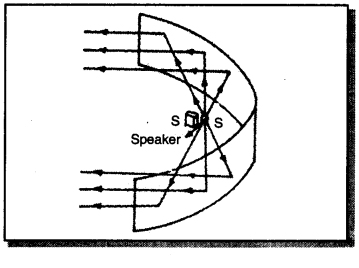
Question 11.
A man claps near a cliff and echo is heard after 5 s. If the velocity of sound is 346 m s-1, then what will be the distance between the man and the cliff?
Solution:
Velocity of sound (v) = 346 m s-1
Time taken for echo to be heard (t) = 5 s
Distance travelled by sound (S) = υ × t
= 346 m s-1 × 5 s
= 1730 m
Sound took 5 s to travel twice the distance between man and cliff
Distance between man and cliff = 1730/2
Question 12.
A ship produces ultrasonic sound which is collected in 3.42 s after reflection from the surface of sea. If the velocity of ultrasonics is 1531 m s-1, then what is the distance of sea surface from sea?
Solution:
Time taken from transmission to collection of sound (t) = 3.42 s
Velocity of ultrasonics in sea water (υ) = 1531 m s-1
Distance travelled by transmitted sound= 2d where d is the depth of sea
2d = velocity of sound × time
2d = 1531 m s-1 × 3.42 s
2d = 5236 m
d = 5236/2
= 2618 m
∴ Distance of ship from sea surface (d) = 618 m
Very Short Answer Type Questions:
Question 1.
What is sound?
Answer:
Sound: It is a kind of energy which produces in us the sensation of hearing.
Question 2.
In which medium the velocity of sound is more – Solids or Gases?
Answer:
In solids, velocity of sound is more i.e. sound travels faster in solids than in gases.
Question 3.
What frequency of sound is audible to human ear?
Answer:
Human ear can hear sound of frequency from 20 Hz to 20,000 Hz.
Question 4.
What is the nature of sound Longitudinal wave or Transverse wave?
Answer:
Longitudinal wave.
Question 5.
What should be the properties of the medium for producing sound waves?
Answer:
The medium should have the property of (i) inertia and (ii) elasticity.
Question 6.
What is the relation between frequency, wavelength and wave velocity?
Answer:
Wave velocity = Frequency × Wavelength.
Question 7.
What is the unit of frequency?
Answer:
Hertz (Hz).
Question 8.
What is the relation between frequency (ν) and time period (T)?
Answer:
ν = 1/T
Question 9.
On dropping a pebble in still water, what type of waves are produced on the surface of water?
Answer:
Transverse waves.
Question 10.
What kind of sound waves are produced in air?
Answer:
Longitudinal waves.
Question 11.
What is the full form of SONAR?
Answer:
The full form of SONAR is Sound Navigation and Ranging.
Question 12.
What is seismograph for?
Answer:
Seismograph is a device used to measure intensity of earthquake.
Question 13.
Which scale measures the intensity of earthquake measured?
Answer:
Richter scale.
Question 14.
Earthquake of what intensity is considered safe on Richter Scale.
Answer:
Earthquake of intensity upto 5 on Richter Scale is considered safe.
Question 15.
What is the cause for production of sound?
Answer:
Vibrations.
Question 16.
What is the time for persistence of hearing?
Answer:
It is 1/10 = 0.1 s.
Question 17.
What is the velocity of sound on moon?
Answer:
Sound cannot travel on moon because moon has no atmosphere.
Question 18.
Which animal can hear infrasonics?
Answer:
Elephant.
Question 19.
What is audible range for human beings?
Answer:
20 Hz to 20,000 Hz.
Question 20.
What is the minimum distance of the obstacle from the source of sound for hearing distinct echo?
Answer:
17.2 m.
Question 21.
Which has a higher pitch, whistle or a drum?
Answer:
Whistle has higher pitch.
Question 22.
A violin and a sitar may have the same frequency, yet we can distinguish between their notes. Why?
Answer:
This is on account of the difference in quality (timbre) of sound produced by them.
Science Guide for Class 9 PSEB Sound InText Questions and Answers
Question 1.
How does the sound produced by the vibrating object in a medium reach your ear?
Answer:
When the vibrating object (such as tuning fork or school bell) moves forward then it compresses the air particles lying just ahead of it which results in production of high pressure region. This region is called compression. This pressure moves forward in the direction in which the object is vibrating, when this vibrat ing object moves backward then a region of low pressure is produced which is known as rarefaction.
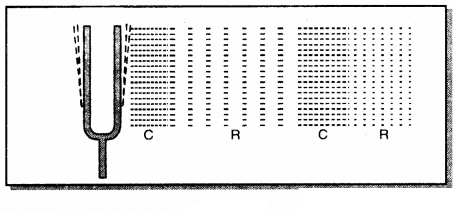
When the vibrating object rapidly moves to and fro then a series of compression and rarefaction pulses are formed i.e. sound wave is produced.
In this way the transmission of sound is caused in the form of transmission of change in density which reaches our ear and forces the tympanic membrane to vibrate. This produces the sensation of hearing in us.
Question 2.
Explain how sound is produced by your school bell?
Answer:
When the school bell is hit with a hammer, it begins to vibrate which produces sound waves. If we gently touch the bell, we feel vibrations. Wave is a disturbance which produces motion in the neighbouring particles of the medium. These particles handover the disturbance in the next particles lying close to the vibrating particles so that sound waves reach us. The particles of the medium do not move from one place to another, it is only the disturbance that travels forward.
Question 3.
Why are sound waves called mechanical waves?
Answer:
Sound is a kind of energy which cannot be produced by itself. To produce it some mechanical enery is required which may be by clapping or by striking bell with a hammer. This sound energy is transmitted in the form of waves by producing disturbance of the particles of the medium. Therefore, sound waves are called mechanical waves.
Question 4.
Suppose you and your friend are on the moon. Will you be able to hear any sound produced by your friend?
Answer:
For propagation of sound, air or some other material medium is required. On the surface of moon there is no such medium present as a result of which sound can not be propagated from one place to another place. So you can neither talk to your friend nor the sound produced by your friend can be heard by you.
Question 5.
Which wave property determines
(a) loudness
(b) pitch?
Answer:
(a) Loudness: The loudness of a sound wave is determined by its amplitude. The amplitude of sound wave depends upon magnitude of force. The more the force, the loud is sound produced. Loud sound traverses more distance because it has more energy in it. The more the sound is away from the source, the less is its loudness. Hence, loudness depends upon square of the amplitude.
(b) Pitch: The frequency of sound produced is called pitch. Frequency determines the aitch of a sound. The more is the vibration of the source, the higher will be its pitch.

So more the frequency, higher the pitch of sound.
In sound of high pitch the number of compressions passing through a fixed point in a unit time will be more.
Question 6.
Guess, which sound has a higher pitch: guitar or a car horn?
Answer:
Though sound of car horn is louder than that of guitar but guitar has higher pitch than car horn.
Question 7.
What are wavelength, frequency, time period and amplitude of a sound wave?
Answer:
1. Wavelength of wave: The distance travelled by the wave during the time, the particle of the medium completes 1 vibration is called wavelength.
Or
The distance between two consecutive compressions or rarefactions in a longitudinal wave or the distance between the consecutive crests or two consecutive troughs is called wavelength. It is denoted by a greek letter ‘λ’ (lambda). SI unit of wavelength is meter (m).

2. Frequency: In any medium when wave propagates the number of vibrations made by a particle of the medium is called frequency. It is denoted by ‘ν’. S.I. unit of frequency is Hertz (Hz). It is determined by the number of compressions or rarefactions passing through a fixed point.
3. Time Period: It is the time taken by a particle to complete one vibration during the propagation of wave. It is denoted by “T”. S.I. unit of time period is second.
Or
Time taken by two nearest compressions or rarefactions of sound waves to cross a point is called time period.
4. Amplitude: The maximum displacement of a particle of the medium on either side of mean position is called amplitude, of wave. It is denoted by letter ‘A’. For sound wave its unit is same as that of pressure or density. The loudness of sound depends on its amplitude.
Question 8.
How are the wavelength and frequency of a sound wave related to its speed?
Answer:
Velocity of sound wave (υ) = Wavelength (λ) × Frequency (ν).
Question 9.
Calculate the wavelength of a sound wave whose frequency is 220 Hz and speed is 440 m s-1 in a given medium.
Solution:
Velocity of sound wave (υ) = 440 ms-1
Frequency of sound (ν) = 220 Hz
Wavelength of sound wave (λ) = ?
We know, υ = ν × λ
440 = 220 × λ
or λ = 440/220
or wavelength (λ) = 2 m
Question 10.
A person is listening to a tone of 500 Hz sitting at a distance of 450 m from the source of sound. What is the time interval between successive compressions from the source?
Solution:
Given frequency of sound (ν) = 500 Hz
Time taken between two successive compressions (T) = ?
We know, time period (T) = 1/Frequency (ν)
= 1/500
= 0.002 s
Question 11.
Distinguish between loudness and intensity of sound.
Answer:
Difference between Loudness and Intensity:
| Loudness | Intensity |
| 1. The loudness of sound is the measure of senstivity of ears. | It is the sound energy passing through a unit area in 1 second. |
| 2. The loudness of sound can not be measured. | The intensity of sound can be measured. |
| 3. For different observers the loudness of sound is different. | The intensity of sound is same for different persons. |
| 4. The loudness of ultrasonic and infrasonic waves is zero because they are inaudible. | There is a possibility of intensity in ultrasonic and infrasonic sound in ultrasonic and infrasonic sound waves. |
Question 12.
In which of the three media, air, water or iron sound travels the fastest at a particular temperature?
Answer:
Sound travels fastest in iron as compared to air and water. The velocity of sound in iron is 5950 m s-1, followed by water [1500 m s-1], air [350 m s-1],
Question 13.
An echo returned in 3 s. What is the distance of reflecting surface from the source? Given that the speed of sound is 342 m s-1.
Solution:
Velocity of sound (v) = 342 ms-1
Time taken for echo to be heard (t) = 3s
Distance travelled by sound (S) = υ × t
= 342 × 3
= 1026 m
i.e. sound takes 3 s to travel from source to reflecting surface and then back to source and during this time the distance travelled is 1026 m.
Distance between source and reflecting surface = 1026/2 m
= 513 m
Question 14.
Why are the ceilings of concert halls curved?
Answer:
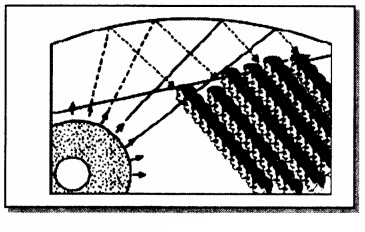
Ceilings of concert halls are made curved as is shown in Fig so that sound after reflection from all surfaces of hall may spread evenly to all parts and heard equally clear.
Question 15.
What is audible range of average human ear?
Answer:
For average human ear the audible range of sound is 20 Hz to 20,000 Hz.
Question 16.
What is the range of frequencies associated with
(a) infrasound
(b) ultrasound?
Answer:
(a) For infrasound the frequency range is less than 20 Hz.
(b) For ultrasound the frequency range is more than 20 KHz (i.e. 20,000 Hz)
Question 17.
A submarine emits a sonar pulse, which returns from an underwater cliff in 1.02 s. If the speed of sound in salt water is 1531 m s-1, how far away is the cliff?
Solution:
Time is taken by the sound to travel from submarine to cliff and back to the submarine
= 1.02 s
Speed of sound in saltwater = 1531 ms-1
Distance travelled by sound (2d) = Speed of sound × Time taken
= 1531 × 1.02 [∵ d is the distance between submarine and cliff]
= 1561.62 m
or d = 1561.62/2 m
i.e. Distance between submarine and cliff (d) = 780.81 m
PSEB 9th Class Science Guide Sound Textbook Questions and Answers
Question 1.
What is sound and how is it produced?
Answer:
Sound: Sound is a form of energy which produces in our ears the sensation of hearing. It is produced due to vibration of a body about its mean position.
How to produce sound? We can produce sound in different bodies by plucking, by rubbing, by blowing or by giving jolt. In other words, by producing vibration in bodies sound can be produced. By vibration we mean moving a body rapidly to and fro about its mean position.
Question 2.
Describe with the help of diagram, how compressions and rarefactions are produced in air near a source of sound?
Answer:
Sound in air gets propagated in the form of longitudinal wave motion consisting of regions of compressions and rarefactions. Consider, for example, a tuning, fork in a state of vibrations. [Fig.(a)] As prong moves towards right, it compresses the layer of air in contact with it. As air has elasticity, the compressed air tends to relieve itself of its strain and moves forward to right to compress the next layer and so on.
Thus, a wave of compression moves towards the right. At the point of compression, there is an increase of pressure and is shown in form of crest C. At the point of rarefaction of concentration of particles is least and has been shown as trough R.
When the prong moves towards left, a region of reduced pressure or rarefaction is produced towards right [Fig. (b)].
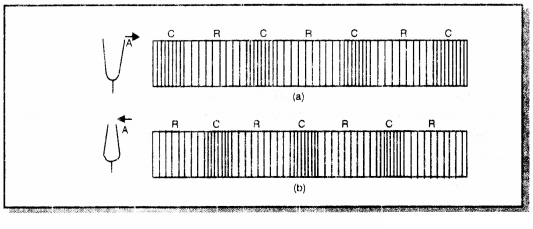
Thus, a wave of rarefaction starts moving towards right. This way a series of compressions arid rarefactions move in forward direction.
Question 3.
Cite an experiment to show that sound needs a material medium for its propagation.
Or
Describe an experiment to show that sound needs a material medium for its propagation.
Or
Describe an activity to show that sound is a mechanical wave and needs a material medium for its propagation.
Answer:
Sound needs material medium for propagation: Sound is a mechanical wave which needs a material medium to travel, (propagate) It can travel through air, water, steel, etc but cannot travel through vacuum. This can be demonstrated by the following experiment.
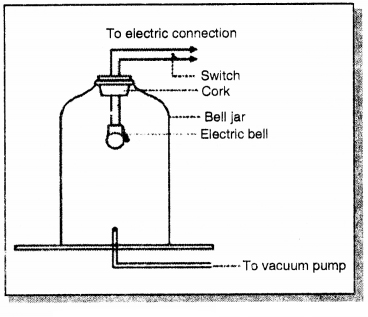
Experiment: Take an electric bell and a glass bell-jar. Suspend the electric bell in a bell jar with the help of a cork fitted in the mouth of the jar. Connect the bell jar to a vacuum pump as shown in Fig. Press the switch of electric bell when sound is heard.
Now work the exhaust pump and remove air from the jar slowly. As air is removed the sound becomes fainter and fainter. After sometime when most of the air is removed, a feeble sound will be heard. If the whole of the air from the jar is removed no sound of electric bell will be heard. This proves that material medium is needed for the propagation of sound.
Question 4.
Why is sound wave called longitudinal wave?
Answer:
Sound waves when travel through a medium, the particles of the medium move to and fro in the same direction in which the disturbance (wave) travels. That is why, the sound waves are called longitudinal waves.
Question 5.
Which characteristic of the sound helps you to identify your friend by his voice while sitting with others in a dark room.
Answer:
On the basis of quality or timbre of sound, we can identify our friend’s voice.
Question 6.
Flash and thunder are produced simultaneously. But thunder is heard a few seconds after the flash is seen. Why?
Answer:
The speed of sound (344 m s-1) is much smaller than the speed of light (3 × 108 m s-1). So thunder is heard a few seconds after the flash is seen although these are produced at the same time.
Question 7.
A person has a hearing range from 20 Hz to 20 KHz. What is the typical wavelength of sound waves in air corresponding to these frequencies? Take the speed of sound in air as 344 ms-1.
Solution:
Given speed of sound (υ) = 344 m s-1
Lower limit of frequency (ν1) = 20 Hz
Upper limit of audible frequency (ν2) = 20 KHz
= 20 × 1000 Hz.
= 20000 Hz
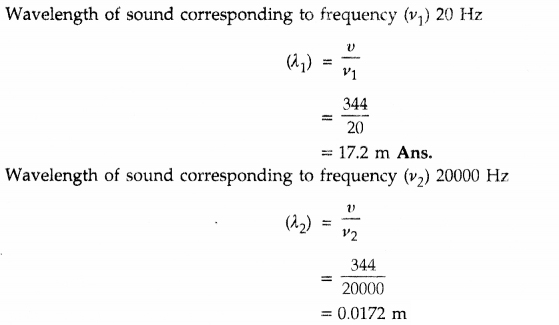
Question 8.
Two children are at opposite er Is of an aluminium rod. One strikes the end of the rod with a stone. Find the ratio of times taken by the sound wave in air and in aluminium to reach the second child.
Solution:
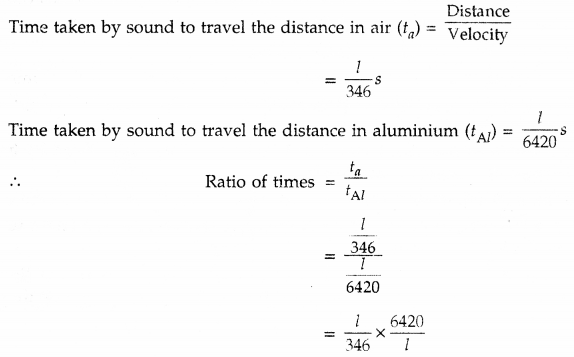

Question 9.
The frequency of source of sound is 100 Hz. How many times does it vibrate in a minute?
Solution:
Frequency of source sound = 100 Hz
i.e, Number of vibrations produced in 1 second = 100
Number of vibrations produced in 1 min = 60 s = 100 × 60 = 6000
Question 10.
Does sound follow the same laws of reflection as light does? Explain.
Answer:
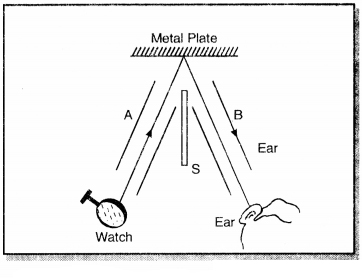
Yes, sound follows the same laws of reflection as light does. Like light sound is reflected from solid or liquid surface.
These laws are:
- First Law: The directions of incident sound and reflected sound make equal angles with the normal to the surface at the point of incidence.
i.e. ∠i=∠r - Second Law: The incident sound wave, the reflected sound wave and normal to the reflecting surface at the point of incidence all lie in the same plane.
Question 11.
When a sound is reflected from a distant object, an echo is produced. Let the distance between the reflecting surface and the source of sound production remains the same. Do you hear echo sound on a hotter day?
Answer:
On a hotter day the speed of sound increases with the increase of temperature. So on that day reflected sound returns tq source earlier than 0.1 s. Hence a clear echo sound can not be heard.
Question 12.
Give two practical applications of reflection of sound waves.
Answer:
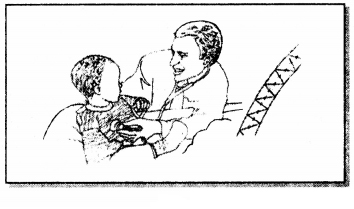
Stethoscope is doctor’s device which is used to hear the sound produced inside heart or lungs. The speed of sound of a patient’s heart beat is guided along the tube to the doctor’s ears by multiple reflection of sound.
2. The front part of musical instruments like megaphone or loudspeaker, horn, shehnai is made open and conical so that the sound waves produced may be reflected repeatedly and may be reflected repeatedly and may be sent forward towards the listeners.
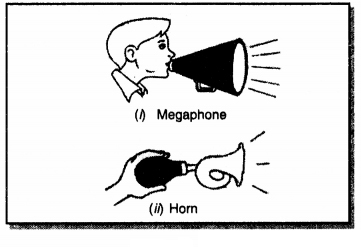
Question 13.
A stone is dropped from the top of a tower 500 m high into a pond of water at the base of the tower. When is the splash heard at the top? Given, g = 10 m s-2 and speed of sound = 340 m s-2.
Solution:
Here, initial velocity of sound (u) = 0
Height of the lower (i.e. distance covered) (S) = 500 m
Acceleration due to gravity (g) = 10 ms-2
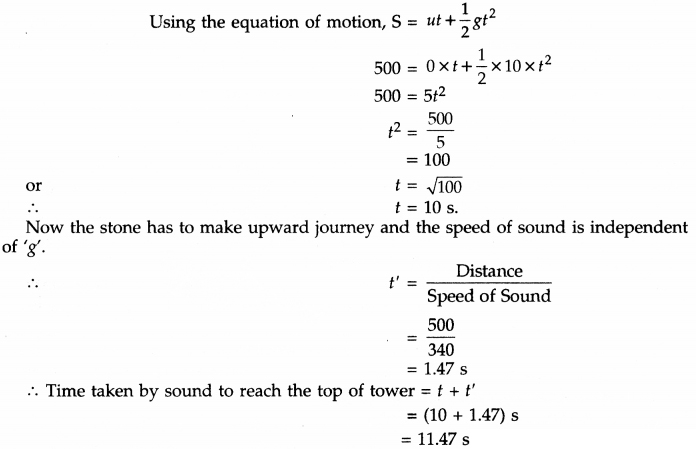
Question 14.
A sound wave travels at a speed of 339 m s-1. If its wavelength is 1.5 cm, what is the frequency of the wave? Will it be audible?
Solution:
Speed of sound (υ) = 339 ms-1
Wavelength of sound (λ) = 1.5 cm
= 1.5/100
= 0.015 m
Frequency of wave (ν) =?
We know, frequency (ν) = υ/λ
= 339/0.015
= 22600 Hz
Yes, sound waves are inaudible because these have frequency 22600 Hz which is not within the audible range 20 Hz to 20,000 Hz.
Question 15.
What is reverberation? How can it be reduced?
Answer:
Reverberation: The persistance of sound due to repeated reflection of sound is called reverberation. If sound after its production is allowed to suffer repeated reflection from walls and ceiling of big halls of concert so that it persists is called reverberation. It is unwanted sound because of which sound is not distinctly heard. To reduce reverberation effect of sound, walls and ceiling should be covered with sound absorbing materials like compressed fiber or heavy curtains having folds etc.
Question 16.
What is loudness of sound? What factors does it depend on?
Answer:
Loudness of sound is the measure of sensitivity of human ears. Like intensity it is not sound energy passing through unit area in 1 second. Two sounds can have same frequencies but still these may be heard having different loudness.
Question 17.
Explain how bats use ultrasounds to catch a prey?
Answer:
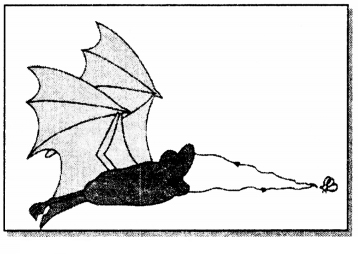
In darkness bats while flying in search of their prey emit ultrasound waves and then detect these waves after reflection. Very high-frequency ultrasonic squeaks of bat are reflected from prey and returned to bat’s ear. Amount and time delay of reflected wave helps bat in estimating the position and distance of prey.
Question 18.
How is ultrasound used for cleaning?
Answer:
Ultrasounds are used to clean parts located in hard-to-reach places e.g., complicated electronic components, watches, spiral or odd shaped parts. Appliances to be cleaned are placed in cleaning solutions and ultrasonic waves are sent through cleaning solution. Due to high frequency of ultrasounds, the dust, oil, grease and dirt get detached.
Question 19.
Explain the working and applications of SONAR.
Or
Write the full name of SONAR. How will you determine the depth of a sea using echo ranging?
Or
Write full form of SONAR. List any two purposes for which, it is used and explain its working for any one such purpose.
Answer:
SONAR: The acronym Sonar stands for Sound Navigation and Ranging. Sonar is a device that uses ultrasonic waves to measure the distance, direction and speed of underwater objects.
Principle: It uses the phenomenon of echoes in determining the sea-depth and locating the presence of underwater objects.
Working: Sonar consists of a transmitter T, and a detector D, installed below a ship as shown in Fig. The wave produced by transmitter travel through water and are reflected by sea-bed of obstacle. Reflected waves are sensed by the detector. Detector converts ultrasonic waves into electric signal. These signals are interpreted by detector.
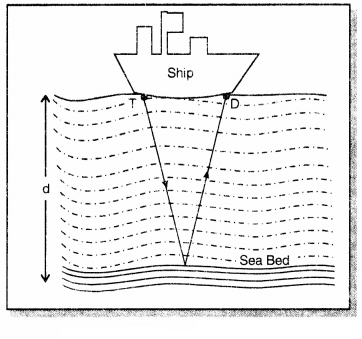
If time interval between transmission and reception is t and speed of sound in sea-water is v, then 2d = υ × t or d = υt/2, where d is the depth of the sea. This method is also called echo sounding.
Practical Applications: It is used to locate underwater submarines, icebergs, sunken ships and underwater hills etc.
Question 20.
A sonar device on a submarine sends out a signal and receives an echo 5 s later. Calculate the speed of sound in water if the distance of the object from submarine is 3,625 m.
Solution:
Time between emission of sound and its collection (t) = 5 s
Depth of sea (2d) = 2 × 3625 m = 7250 m
We know, 2d = Speed of sound × Time
7250 = Speed of sound × 5
∴ Speed of sound (υ) = 7250/5
= 1450 m s-1
Question 21.
Explain how defects in a metal block can be detected using ultrasound?
Answer:
In industries metallic components are used in the construction of big structures like buildings, bridges, machines, scientific equipments, etc. ultrasounds (ultrasonic waves) are used to detect the internal defects or cracks in big metallic blocks which are not visible from outside.
Ultrasonic waves are allowed to pass through the metal block and detectors are used to detect the transmitted waves. If there is even a small defect, the ultrasound gets reflected back and does not reach the detector, as shown in figure. This indicates the presence of a defect.
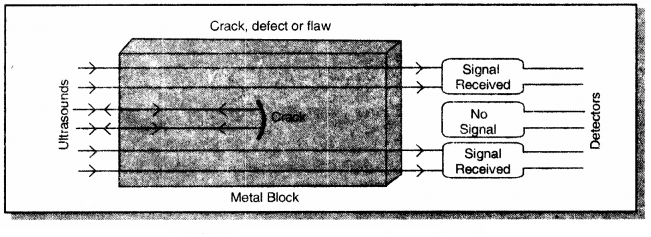
Question 22.
Explain how the human ear works.
Answer:
Ear is very sensitive device used to hear sound. It converts compressions and rarefactions of frequency range 20 Hz to 20,000 Hz into electric signals that travel to brain via auditory nerve.
The ear consists of three sections:
- the outer ear,
- the middle ear and
- the inner ear.
The outer ear consists of Pinna and Auditory Canal. Pinna is a cup-shaped fleshy part of the outer ear. Pinna collects and amplifies sound waves which then pass on the auditory canal. At the end of auditory canal, there is a thin membrane called tympanic membrane or eardrum. When compression reaches the eardrum, the pressure on membrane increases and the ear drum is forced inwards. When rarefaction reaches the eardrum, it moves outwards.
The vibrations are amplified by lever action of three bones called hammer, anvil and stirrup in the middle ear. In turn, the middle ear transmits the amplified pressure variations to the inner ear. The amplified pressure variations are converted into electric signals by cochlea in the inner ear. The electric signals generated are conveyed to the brain
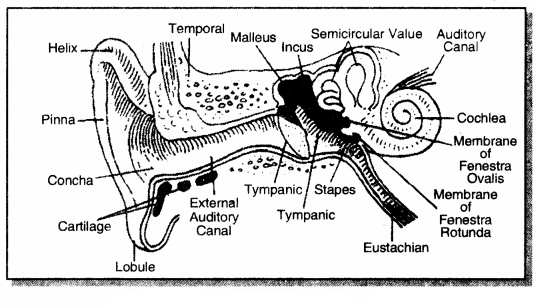
via the auditory nerve. The brain interprets them as sound. In fact we do not hear with ear. We hear with brain through ears.
Follow on Facebook page – Click Here
Google News join in – Click Here
Read More Asia News – Click Here
Read More Sports News – Click Here
Read More Crypto News – Click Here